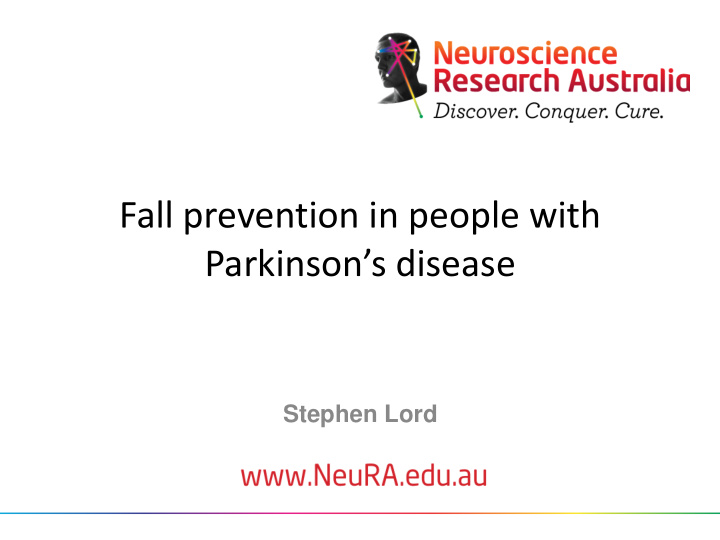



Fall prevention in people with Parkinson’s disease Stephen Lord
Why are falls a problem? • One in three people 65 years and older living in the community fall at least once per year • The rate is higher for people with Parkinson’s disease (50-60%) • Falls account for 4% of all hospital admissions in people aged 65+ • By 2051 one quarter of the Australian population will be aged 65 years and over
Consequences of falls • 10-15% of falls result in major injuries - soft tissue damage, head trauma, dislocations and fractures • Reduced quality of life and independence- due to disability, loss of confidence and activity restriction • Can result in need for residential aged care • Can result in death - more than 1000 people in Australia each year
Established fall risk factors in PD • Having had a fall in the past • Being concerned about falls • More PD symptoms – greater disease severity • Cognitive impairment • Loss of arm swing • More episodes of freezing • More stooped posture
Fall risk in Parkinson’s disease: What we have found so far • Reduced strength and power • Slower reaction time • Impaired executive functioning • Poorer controlled leaning balance • Less smooth walking pattern • Slow choice stepping reaction time • Impaired gait adaptability • Reduced ability to respond appropriately to perturbations while standing or walking
Fall prevention in P arkinson’s disease
Exercise interventions in PD 53% reduction in falls overall
New approaches Lancet 2016; 388: 1170 – 82
Methods • 202 participants assigned to either treadmill training plus virtual reality or treadmill training alone • Both groups aimed to train three times per week for 6 weeks, with each session lasting about 45 min and structured training progression individualised to the participant's level of performance • Stratified by subgroups: history of falls (109), mild cognitive impairment (43), Parkinson’s disease (130)
The Virtual Reality intervention The Virtual Reality system consisted of a motion-capture camera and a computer-generated simulation projected on to a large screen, including challenges such as obstacles, multiple pathways, and distracters that required continual adjustment of steps.
Falls • 51% reduction in the PD participants
Safe-PD Voluntary and reactive step training in people with PD • 44 people with PD (> 40 years); • Community dwellers; idiopathic PD; • Exclusion criteria: visual, cognitive or other neurological impairments and insufficient English skills • Randomised controlled trial ACTRN12618001515280 Aims: to examine the effects of combined voluntary and reactive step training on: • Falls in the laboratory and stepping responses • Balance, gait and mobility • Neuropsychological function (i.e. cognitive performance) • Neural plasticity (i.e. changes in brain function assessed with fNIRS)
Unpredictable trip and slip training Ceiling rail Damper Infrared cameras Weight scale Safety harness Control PC Metronome Stepping tiles Foot detection sensor The slipping tile The tripping board
TRIPS
SLIPS
Home-based system
Smart±Step Interventions
Study progress • Recruitment completed May 2019 • Study completed as of 20 September 2019 • Dropout < 10% • Both interventions feasible and acceptable • Analysis underway • Trip and slip training may be better on a programmable perturbation treadmill
NHMRC application – with everyday falls as the main outcome measure
Thank you
Recommend
More recommend